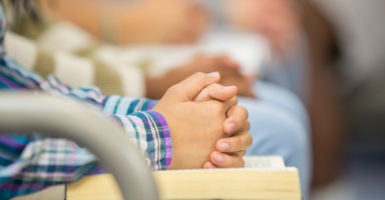How does a young man find himself standing behind the president of the United States in the Oval Office of the White House?
Actually, I invited several friends during my freshman year at Pine Creek High School in Colorado Springs, Colorado. We had a free period in the middle of the school day. A lot of my classmates used the time to just hang out, or to text or talk about their plans for the weekend.
I thought it might be a good time to find an empty room and a few good friends who would enjoy praying together and encouraging one another in our shared faith.
We did that for three years. Gradually, word got around, and more and more young people joined us.
By the time I was a senior, some 90 other students were in that room twice a week. We enjoyed a strong sense of community as we met to pray for each other, our teachers and school, and even our nation.
During my senior year, however, something changed. I was summoned to the assistant principal’s office and told that this uplifting, student-led prayer time violated the so-called “separation of church and state.”
If we wanted to continue to meet, we were told, it would have to be either before classes started at 7:45 a.m. or after they ended, at 2:45 p.m.
I knew full well there were other informal groups meeting during the free period to engage in other activities, so I tried to explain our right to pray and how using the free period was important to us.
Most of the students joining us had jobs, sports activities, or other commitments before and after school. This free period was the only time we could all meet, and we were meeting outside of class time.
No one was pressured to join the group. Only people who wanted to be there attended—some of whom weren’t even Christians. And besides, we were carrying on a great American tradition.
From the time of our nation’s Founding Fathers, people had been meeting in public places—including public schools—to pray.
Banning us from praying was going against the grain of our nation’s history and violated the Constitution.
I was a senior, getting ready to graduate. Getting involved in a federal lawsuit was the last thing on my mind. I couldn’t understand why I should have to take legal action to persuade our school administrators to honor our constitutionally protected freedoms.
No one in this country should ever have to go to court to win permission to pray. But when repeated conversations with administrators went nowhere, legal action seemed the only way to ensure the right to pray for other students who would be coming after me in the future.
I contacted Alliance Defending Freedom and asked it to file a federal lawsuit on my behalf. Eventually, the school settled that suit by agreeing to allow students to pray and talk about their faith in our free time during school hours.
More than four years later, the case came to President Donald Trump’s attention, and his team invited me to be on hand on Jan. 16, when, as part of national Religious Freedom Day, he announced several new measures to protect the religious liberties of students on American campuses.
One of those measures is an updated Guidance on Constitutionally Protected Prayer and Religious Expression in Public Elementary and Secondary Schools. As part of that directive, public schools are required to certify that students’ free speech and free exercise rights under the U.S. Constitution do not go away when those students step onto school property.
Students have the freedom to thoughtfully exercise those rights—and school officials are directed not to break up student-led prayer meetings that don’t obstruct school activities.
This journey has been much more than what I expected when I first asked those high school friends of mine to pray with me that day.
I’m humbled to have been a part of it. And to the students of the next generation, I encourage you to boldly live out your faith in Jesus in seemingly small and unseen ways, because He is worthy, and you never know where faithful obedience will take you.
I’m thankful to the president and his administration for valuing religious liberty and thus defending for students across the United States what our Founders set in motion nearly 250 years ago. I’m confident that we will continue to be a nation where all people may freely practice their faith without hindrance or fear.




























